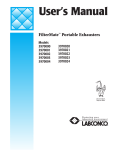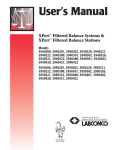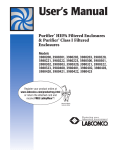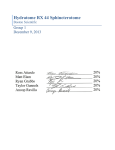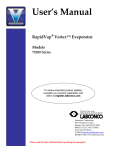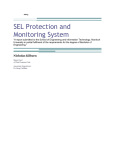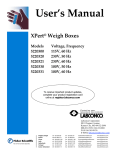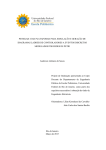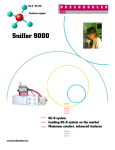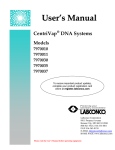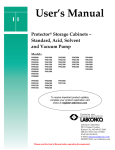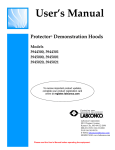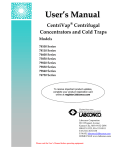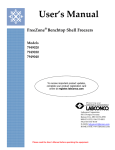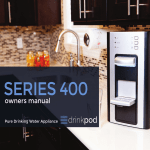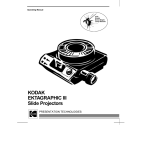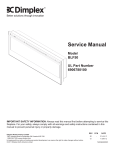Download Fume Adsorbers User`s Manual
Transcript
User’s Manual Fume Adsorbers Models 115V 230V 3955200 Organic 30" 3955400 Organic 60" 3955201 Formaldehyde 30" 3955401 Formaldehyde 60" 3955202 Ammonia 30" 3955402 Ammonia 60" 3955220 Organic 30" 3955420 Organic 60" 3955221 Formaldehyde 30" 3955421 Formaldehyde 60" 3955222 Ammonia 30" 3955422 Ammonia 60" To receive important product updates, complete your product registration card online at register.labconco.com Labconco Corporation 8811 Prospect Avenue Kansas City, MO 64132-2696 800-821-5525, 816-333-8811 FAX 816-363-0130 E-MAIL [email protected] HOME PAGE www.labconco.com Please read the User’s Manual before operating the equipment. Copyright © 2005, 2007 Labconco Corporation. All rights reserved. The information contained in this manual and the accompanying products are copyrighted and all rights reserved by Labconco Corporation. Labconco Corporation reserves the right to make periodic design changes without obligation to notify any person or entity of such change. Warranty Labconco provides a warranty on all parts and factory workmanship. The warranty includes areas of defective material and workmanship, provided such defect results from normal and proper use of the equipment. The warranty for all Labconco products will expire one year from date of installation or two years from date of shipment from Labconco, whichever is sooner, except the following; • • • • • Purifier® Delta® Series Biological Safety Cabinets and PuriCare® Lab Animal Research Stations carry a three-year warranty from date of installation or four years from date of shipment from Labconco, whichever is sooner. SteamScrubber® & FlaskScrubber® Glassware Washers carry a two-year warranty from date of installation or three years from date of shipment from Labconco, whichever is sooner. Blood Drawing Chairs carry a ten year warranty. Carts carry a lifetime warranty. Glassware is not warranted from breakage when dropped or mishandled. This limited warranty covers parts and labor, but not transportation and insurance charges. In the event of a warranty claim, contact Labconco Corporation or the dealer who sold you the product. If the cause is determined to be a manufacturing fault, the dealer or Labconco Corporation will repair or replace all defective parts to restore the unit to operation. Under no circumstances shall Labconco Corporation be liable for indirect, consequential, or special damages of any kind. This statement may be altered by a specific published amendment. No individual has authorization to alter the provisions of this warranty policy or its amendments. Lamps and filters are not covered by this warranty. Damage due to corrosion or accidental breakage is not covered. Returned or Damaged Goods Do not return goods without the prior authorization from Labconco. Unauthorized returns will not be accepted. If your shipment was damaged in transit, you must file a claim directly with the freight carrier. Labconco Corporation and its dealers are not responsible for shipping damages. The United States Interstate Commerce Commission rules require that claims be filed with the delivery carrier within fifteen (15) days of delivery. Limitation of Liability The disposal and/or emission of substances used in connection with this equipment may be governed by various federal, state, or local regulations. All users of this equipment are required to become familiar with any regulations that apply in the user’s area concerning the dumping of waste materials in or upon water, land, or air and to comply with such regulations. Labconco Corporation is held harmless with respect to user’s compliance with such regulations. Contacting Labconco Corporation If you have questions that are not addressed in this manual, or if you need technical assistance, contact Labconco’s Customer Service Department or Labconco’s Product Service Department at 1-800-821-5525 or 1-816-333-8811, between the hours of 7:00 a.m. and 6:00 p.m., Central Standard Time. Part #6960400, Rev. D ECO E242 TABLE OF CONTENTS CHAPTER 1: INTRODUCTION About This Manual Typographical Conventions 1 3 4 CHAPTER 2: PREREQUISITES Support Requirements Location and Air Current Requirements Electrical Requirements Space Requirements 5 6 6 6 6 CHAPTER 3: GETTING STARTED Unpacking Your Enclosure Installing the Enclosure on a Supporting Structure Installation of Carbon Filters Connect the Electrical Supply Source to the Enclosure Validating the Fume Adsorber Face Velocity 7 8 8 9 10 10 CHAPTER 4: PERFORMANCE FEATURES AND SAFETY PRECAUTIONS Performance Features Safety Precautions CHAPTER 5: APPROPRIATE APPLICATIONS FOR YOUR ENCLOSURE Routine Daily Work Procedures Suitable Applications Appropriate Chemicals for Carbon Filters Definition of Terms Hazardous Misapplications for Carbon Filters with Volatile Chemicals Chemical Carcinogen Use with Carbon Filters Prohibited Acid Use 11 11 13 16 16 17 18 19 20 20 20 CHAPTER 6 MAINTAINING YOUR ENCLOSURE Routine Maintenance Schedule Determination of When to Replace Carbon Filters and How to Replace Calculating Carbon Filter Life 21 22 CHAPTER 7 TROUBLESHOOTING 27 APPENDIX A: ENCLOSURE COMPONENTS AND REPLACEMENT PARTS 29 APPENDIX B: DIMENSIONS 32 APPENDIX C: FUME ADSORBER SPECIFICATIONS 33 APPENDIX D: QUICK CHART FOR THE FUME ADSORBER 35 APPENDIX E: REFERENCES 36 DECLARATION OF CONFORMITY 38 23 25 CHAPTER 1 INTRODUCTION Congratulations on your purchase of a Labconco Fume Adsorber. Your enclosure uses carbon filtration to provide personnel protection of annoying solvents, formaldehyde or ammonia vapors generated by histology and pathology operations. When properly installed and operated, these enclosures will effectively contain low concentrations of noxious fumes and chemicals. Each enclosure uses carbon filtration and is only intended for chemical use with a time weighted exposure limit (TWA) of 100 ppm or greater (Reference the NIOSH Pocket Guide, www.cdc.gov/niosh/npg/npg.html). The carbon filters are available with three different carbons for adsorbing organic vapors, formaldehyde or ammonia and amines. Please acquaint yourself with this manual and keep it handy for future reference to review all the Fume Adsorber’s features. If you are unfamiliar with how Fume Adsorbers operate, please review Chapter 4: Performance Features and Safety Precautions before you begin working in the enclosure. Even if you are an experienced user, please review Chapter 5: Using Your Fume Adsorber, which describes the features so that you can use the enclosure efficiently. Product Service 1-800-522-7658 1 Chapter 1: Introduction Fume Adsorber Model No’s. Filter Blower Application Exhaust 30" 3955200 (115V) 3955220 (230V) Carbon Filter* Organic Vapor Built-In Integral Motorized Impeller To the room 60" 3955400 (115V) 3955420 (230V) When ducting to the outside is not feasible, the filters keep low level concentrations below OSHA recommended time weighted averages, restoring clean air to the laboratory. Fume Adsorber Model No’s. Filter Blower Application Exhaust 30" 3955201 (115V) 3955221 (230V) Carbon Filter*, Formaldehyde Built-In Integral Motorized Impeller 60" 3955401 (115V) 3955421 (230V) Width Width When ducting to the outside is not feasible, the filters keep low level concentrations below OSHA recommended time weighted averages, restoring clean air to the laboratory. To the room Note: Formaldehyde filters can adsorb up to 30% organic vapors. Width Fume Adsorber Model No’s. 30" 3955202 (115V) 3955222 (230V) 60" 3955402 (115V) 3955422 (230V) Filter Blower Application Exhaust Carbon Filter*, Ammonia Built-In Integral Motorized Impeller When ducting to the outside is not feasible, the filters keep low level concentrations below OSHA recommended time weighted averages, restoring clean air to the laboratory. To the room Note: Ammonia filters can adsorb up to 30% organic vapors. * It is recommended that a Labconco product specialist review the chemical application to determine if it is suitable. Consult Chapter 5 and Chapter 6. ! 2 Acids must not be used in Fume Adsorbers. Product Service 1-800-522-7658 Chapter 1: Introduction About This Manual This manual is designed to help you learn how to install, use, and maintain your enclosure. Instructions for installing accessory carbon filters on your filtered enclosure are also included. Your Fume Adsorber ships with either one or two organic vapor carbon filters depending on the model width. Chapter 1: Introduction provides a brief overview of the enclosure, explains the organization of the manual, and defines the typographical conventions used in the manual. Chapter 2: Prerequisites explains what you need to do to prepare your site before you install the enclosure. Electrical and service requirements are discussed. Chapter 3: Getting Started contains the information you need to properly unpack, inspect, install, and certify the enclosure. Chapter 4: Performance Features and Safety Precautions explains how the enclosure operates and the appropriate precautions you should take when using it. Chapter 5: Appropriate Applications for Your Enclosure discusses the basic operation of how to prepare, use and shut down your enclosure. Chapter 6: Maintaining Your Enclosure explains how to perform routine maintenance on the enclosure. Chapter 7: Troubleshooting contains a table of problems you may encounter while using the enclosure including the probable causes of the problems and suggested corrective actions. Appendix A: Components and Replacement Parts contains labeled diagrams of all of the components of the enclosures. Appendix B: Dimensions contains comprehensive diagrams showing all of the dimensions for the enclosures. Product Service 1-800-522-7658 3 Chapter 1: Introduction Appendix C: Specifications contains the electrical requirements for enclosures. Wiring diagrams are also included. Appendix D: Quick Chart provides an airflow table and test data for the enclosures. Appendix E: References lists the various resources available that address laboratory ventilation. Typographical Conventions Recognizing the following typographical conventions will help you understand and use this manual: • • • ! • • ) 4 • Book, chapter, and section titles are shown in italic type (e.g., Chapter 3: Getting Started). Steps required to perform a task are presented in a numbered format. Comments located in the margins provide suggestions, reminders, and references. Critical information is presented in boldface type in paragraphs that are preceded by the exclamation icon. Failure to comply with the information following an exclamation icon may result in injury to the user or permanent damage to the enclosure. Critical information is presented in boldface type in paragraphs that are preceded by the wrench icon. Only a trained certifier or contractor should perform these operations. Failure to comply with the information following a wrench icon may result in injury to the user or permanent damage to your enclosure. Important information is presented in capitalized type in paragraphs that are preceded by the pointer icon. It is imperative that the information contained in these paragraphs be thoroughly read and understood by the user. Product Service 1-800-522-7658 CHAPTER 2 PREREQUISITES Before you install the Fume Adsorber, prepare your site for installation. A source of electrical power should be located near the installation site to power the enclosure. Additionally, the enclosure should be strategically placed in the lab to provide efficient workflow. Carefully read this chapter to learn the requirements for your installation site: • • • • The support requirements. The location and air current requirements. The electrical power requirements. The space requirements. Refer to Appendix B: Dimensions for complete enclosure dimensions. Refer to Appendix C: Specifications for complete enclosure electrical and environmental conditions, specifications and requirements. Product Service 1-800-522-7658 5 Chapter 2: Prerequisites Support Requirements At a minimum, the supporting structure usually consists of a work surface in the laboratory. See Chapter 3 for setting up installation. Location and Air Current Requirements The Fume Adsorbers have been designed to contain hazardous fumes by negating typical cross drafts and turbulence within the opening. As precautionary safety measure and a higher level of quality management, it is recommended that the Fume Adsorber be placed in an area to avoid: • • • High traffic areas where walking might cause an air disturbance or be a nuisance. Overhead or wall HVAC diffusers, fans, radiators or other lab equipment producing air currents. Next to doorways or windows that may be opened. Electrical Requirements Standard duplex electrical receptacles should be nearby for connecting the Fume Adsorber. See the nameplate on the rear of the enclosure for rated electrical service. Space Requirements The dimensions for the different Fume Adsorber models are shown in Appendix B: Dimensions. 6 Product Service 1-800-522-7658 CHAPTER 3 GETTING STARTED Now that the site for your Fume Adsorber is properly prepared, you are ready to unpack, inspect and install the enclosure. Read this chapter to learn how to: • Unpack and move the enclosure. • Set up the enclosure with the proper supporting structure. • Installation of carbon filter(s). (Fume Adsorbers ship with organic vapor filter(s). • Connect the electrical supply. • Validate the enclosure face velocity. Product Service 1-800-522-7658 7 Chapter 3: Getting Started Unpacking the Enclosure The United States Interstate Commerce Commission rules require that claims be filed with the delivery carrier within fifteen (15) days of delivery. Carefully remove the shrink-wrap and carton on the unit and inspect it for damage that may have occurred in transit. If damaged, notify the delivery carrier immediately and retain the entire shipment intact for inspection by the carrier. ) DO NOT RETURN GOODS WITHOUT THE PRIOR AUTHORIZATION OF LABCONCO. UNAUTHORIZED RETURNS WILL NOT BE ACCEPTED. ) IF ENCLOSURE WAS DAMAGED IN TRANSIT, YOU MUST FILE A CLAIM DIRECTLY WITH THE FREIGHT CARRIER. LABCONCO CORPORATION AND ITS DEALERS ARE NOT RESPONSIBLE FOR SHIPPING DAMAGE. Do not discard the packing material until you have checked all of the components and tested the enclosure. We recommend that you do not remove the enclosure from its shipping container until it is ready to be placed in its final location. Installing the Enclosure on a Supporting Structure Use caution when lifting or moving the enclosure. When installing the enclosure onto a chemical-resistant work surface or benchtop, ensure that the structure can safely support the weight of the enclosure. The 30" wide Fume Adsorber weighs 62 lbs, and the 60" wide Fume Adsorber-2 weighs 125 lbs. The work surface should be at least as wide as the enclosure to properly support it. 8 Product Service 1-800-522-7658 Chapter 3 Getting Started: Installation of Carbon Filters For carbon filter installation, first remove the four (or eight) Phillips screws on the perforated baffle located inside the enclosure. Slowly remove the perforated baffle. See the following list of available carbon filters below. All carbon filters are installed with the gasket side on the downstream exhaust side. The carbon filters are installed behind the upper and lower filter clamps and are removed by Phillips screws. Install the correct carbon filter for the application. In choosing the correct filter for your application call Labconco for assistance. See Figures A-1, A-2 and A-3 in Appendix A and Figure 4-2 in Chapter 4 for installation diagrams. Filter Type Organic Vapor Activated Carbon 6961300 6.0 lbs. Formaldehyde (Formalin) 6961301 7.5 lbs. Ammonia and Amines 6961302 8.7 lbs. ! Appropriate Use Adsorbs organic compounds designated by NIOSH guidelines as acceptable for use with chemical cartridge-type respirators. Concentrations in the enclosure’s work area must not exceed the IDLH for the chemical and the exhaust from the enclosure must be monitored not to exceed the TWA. Formaldehyde requires the use of an impregnated carbon. Concentrations in the enclosure’s work area must not exceed the IDLH for the chemical and the exhaust from the enclosure must not exceed the TWA. Treats ammonia, low molecular weight amines and other bases designated by NIOSH as acceptable for use with ammonia cartridge type respirators. Requires the use of an impregnated carbon. Concentrations in the enclosure’s work area must not exceed the IDLH for the chemical and the exhaust from the enclosure must not exceed the TWA. Important: Carbon filters do not provide any particulate protection, but provide odor control for low level concentrations below OSHA recommended time weighted averages. Product Service 1-800-522-7658 9 Chapter 3: Getting Started 115V The maximum circuit load is 2 amps. Connecting the Electrical Supply Source to the Enclosure 115V Models Simply connect the 115V power cord supplied to the IEC electrical supply plug on the back of the enclosure. 230V Models 230V The maximum circuit load is 1 amp. The same procedure applies for the 230V except it is shipped without a plug. Install the appropriate plug for your electrical specifications per local codes. Validating the Fume Adsorber Face Velocity To determine the actual face velocity at the sash opening, airflow velocity readings are taken. The “average face velocity” is achieved by taking readings in two rows across the enclosure with the readings 6" from the ends and evenly spaced every 12". The average velocity across the opening of the enclosure is 35 fpm and should be validated. Do not use the enclosure with an average velocity of less than 25 fpm. Consult your safety officer. ! 10 NOTE: Face velocity profiles and smoke testing should be performed at least monthly. Product Service 1-800-522-7658 CHAPTER 4 PERFORMANCE FEATURES AND SAFETY PRECAUTIONS Performance Features: The Fume Adsorbers are designed to meet the needs of the laboratory scientist and provide containment of light emissions of solvents, formaldehyde and ammonia vapors. Annoying vapors, such as xylene and toluene fumes used in cover slipping operations are efficiently adsorbed by the Fume Adsorber carbon filter(s). The Fume Adsorber uses a carbon filter to collect low concentrations and exhaust filtered air back into the room. Product Service 1-800-522-7658 11 Chapter 4: Performance Features and Safety Precautions 2 3 4 Figure 4-1 Performance Features 1 3 2 5 Figure 4-2 Performance Features, Exploded View 12 Product Service 1-800-522-7658 Chapter 4: Performance Features and Safety Precautions 1. Built-In Motorized Impeller Provides up to 35 fpm average face velocity. Airflow capacity is 100 CFM on the 30" wide unit and 200 CFM on the 60" wide unit. 2. Perforated Baffle provides uniform removal of noxious fumes. Remove this baffle to access the carbon filter. 3. Blower Switch provides convenient ON/OFF control. 4. Hood Canopy maximizes the work area and visibility. 5. Carbon Filter is designed to remove small amounts of fumes and chemicals. (See Chapter 6 for carbon types and estimated filter life.) Safety Precautions 1. Although the enclosure has been engineered to maintain optimum operator safety, caution should always be used while working inside the enclosure. Prior to using, check to make sure that the exhaust blower is operating and air is entering the enclosure at its specified face velocity. 2. Use good housekeeping in the enclosure at all times. Clean spills immediately. Periodically clean the enclosure interior with mild soap and water. 3. Do not store containers or supplies against the rear baffle, as this will affect airflow. Blocking large portions of the rear baffle will change the airflow pattern in the enclosure causing turbulence. 4. Always work with your hands as far back into the enclosure as possible. 5. Do not work in this enclosure without the exhaust system running. 6. General acid use, as well as perchloric acid use in this enclosure is prohibited. 7. High-level radioisotope materials are prohibited in this enclosure. Consult your Safety Officer. 8. Avoid cross drafts and limit traffic in front of the enclosure. Air disturbances created may draw chemical vapors out of the enclosure. 9. The use of safety goggles, protective clothing, gloves and any other personal protective equipment recommended by your safety officer should be used. Product Service 1-800-522-7658 13 Chapter 4: Performance Features and Safety Precautions 10. Care must be taken to ensure that the concentration of gases or vapors do not reach flammable or explosive limits. Use of an open flame must be avoided in the enclosure. 11. Applications that generate gases or vapors from toxic chemicals must be evaluated carefully so that buildup to levels above the TWA of the chemical does not occur. Do not work with chemicals having a TWA below 100 ppm. 12. Ensure that the enclosure is connected to electrical service in accordance with local and national electrical codes. Failure to do so may create a fire or electrical hazard. Do not remove or service any electrical components without first disconnecting the enclosure from electrical service. 13. Dispose of carbon filters as hazardous waste. The user is responsible for recording the chemicals adsorbed or treated by the filters and disposing properly. 14. Ensure only trained operators use the enclosure. New users should review the User’s Manual and become familiar with the operation of the enclosure. 15. If the enclosure is to be used in a confined space, make sure the space is well ventilated and the concentration of chemical vapors cannot accumulate greater than the TWA. 16. Only chemicals that can be safely adsorbed and treated with specific carbon-based filters are appropriate for use in this enclosure. Contact Labconco for chemical assessment. 17. The warning properties (i.e., odor, taste) of the volatile organic compounds or other material being used in the enclosure must be adequate to provide an early indication that the carbon filters may be saturated or inadequate. Contact Labconco for help with chemical assessment. 18. Use the smallest possible quantity of chemical(s) within the enclosure and never exceed the amount that can be effectively adsorbed by the carbon filters before breakthrough. Consult Chapter 6 for filter life estimates. 19. Leave the blower on for at least one minute after work in the enclosure has been completed. 20. If a chemical is spilled on the work surface, DO NOT switch off the blower until all traces have been removed. 14 Product Service 1-800-522-7658 Chapter 4: Performance Features and Safety Precautions 21. Tag the enclosure with appropriate warning if filters have been removed for service. 22. If the blower fails during use, processes should cease and the area should be vacated and ventilated. 23. Always refer to the NIOSH Pocket Guide to Chemical Hazards to understand the chemical’s properties and health risks. (See Chapter 5). For additional help with filter and chemical selection contact Labconco at 1-800-821-5525 or 1-816-333-8811. Product Service 1-800-522-7658 15 CHAPTER 5 APPROPRIATE APPLICATIONS FOR YOUR ENCLOSURE Now that the installation of your enclosure is completed, you are ready to use your Fume Adsorber. Read this chapter to learn about: 1. Routine Daily Work Procedures. 2. Suitable Applications. 3. Appropriate Chemicals for Carbon Filters. 4. Definition of Terms. 5. Hazardous Misapplications for Carbon Filters. 6. Chemical Carcinogen use with Carbon Filters. 7. Prohibited Acid Use. Start-up • Turn on exhaust system blower with the ON/OFF switch. • Check the baffle air slots for obstructions. • Wear a long sleeved lab coat and rubber gloves. Use protective eyewear. Wear a protective mask if appropriate. Consult your Safety Officer for additional personal protective equipment recommendations. • Load only the materials required for the procedure. Do not overload the enclosure. 16 Product Service 1-800-522-7658 Chapter 5: Appropriate Applications for Your Enclosure Work Techniques • Keep all materials inside the enclosure and perform all contaminated operations as far to the rear of the work area as possible. • Avoid using techniques or procedures that disrupt the airflow patterns of the enclosure. Final Purging • Upon completion of work, the enclosure should be allowed to operate for two to three minutes undisturbed, to purge airborne contaminants from the work area before shutting off the blower. Shutdown • Turn off the exhaust system blower with the ON/OFF switch. Suitable Applications NIOSH (National Institute for Occupational Safety and Health, USA) has established guidelines for chemical cartridge and HEPA filtered respirators. Suitable applications for the carbon filtered enclosures are based on guidelines below. As with respirators, chemical contaminants are adsorbed or treated by carbon. • • • • Release of low concentrations of vapors effectively adsorbed or treated in carbon based filters. Recommended for use with chemicals with a TWA of 100 or greater unless chemical can be filtered with the use of an impregnated specialized filter; impregnated filters such as formaldehyde, formalin, ammonia, and amines are examples of specialized filters. Treatment of low-level carcinogens or suspected carcinogens. (See Chemical Carcinogens in Chapter 5) Procedures that may have traditionally been done on the open bench (low levels only). Odoriferous chemicals that are an unpleasant nuisance. Other applications, not fitting the above guidelines, would be better suited with the exhaust ducted to the outside by using some other containment enclosure offered by Labconco. ) REFERENCES TO NIOSH OR OSHA GUIDELINES AND REGULATIONS APPLY TO ANY WORK PLACE UNDER THE JURISDICTION OF THE U.S. DEPARTMENT Product Service 1-800-522-7658 17 Chapter 5: Appropriate Applications for Your Enclosure OF LABOR. OTHER COUNTRIES OUTSIDE THE U.S. HAVE ESTABLISHED STANDARDS, WHICH MAY DIFFER SLIGHTLY FROM THOSE USED AS GUIDELINES FOR THIS PRODUCT. IT IS THE USER’S RESPONSIBILITY TO BECOME AWARE OF LOCAL REGULATIONS GOVERNING THE SAFE USE AND DISPOSAL OF CHEMICALS AND CARBON FILTERS. KNOWLEDGE OF ESTABLISHED SAFE EXPOSURE LEVELS IS IMPERATIVE TO THE PROPER USE OF CARBON FILTERED ENCLOSURES. Appropriate Chemicals for Carbon Filters Below is a general set of rules to determine appropriateness of chemical usage. ! Selected organic chemicals considered to be occupational carcinogens by NIOSH can only be used in the filtered enclosure with carbon filters under rigid restrictions. See separate discussion on next page on carcinogens for special instructions. Organics must have time weighted exposure limits (TWA) of 100 PPM or greater. Chemicals must have a detectable odor at concentrations below the TWA for the chemical. Chemicals must be designated by NIOSH guidelines as acceptable for use with chemical cartridge-type respirators (the exception is formaldehyde and ammonia/amines, which used impregnated carbon). Chemicals not listed by NIOSH in the Pocket Guide must be approved by Labconco Product Specialist (or Engineering). Inlet concentration must never exceed the IDLH (Immediately Dangerous to Life and Health) concentrations. Chemicals having a recommendation by NIOSH of at least “Escape GMFOV” (Gas Mask Full-Face Respirator). When evaporating a mixture of chemicals, the chemical having the lowest TWA will be used to determine if the mixture meets the guidelines. 18 Product Service 1-800-522-7658 Chapter 5: Appropriate Applications for Your Enclosure Call a Labconco Product Specialist at 1-800-821-5525 for assistance in determining chemical appropriateness. Definition of Terms NIOSH – National Institute for Occupational Safety and Health/Mine Safety and Health Administration. (U.S.A.) TWA – Recommended Exposure Limits expressed as a Time Weighted Average. The exposure limit for that chemical for up to a 10-hour workday, 40 hours a week. Expressed in units of parts per million or milligrams per cubic meter. Odor Threshold – The value in parts per million or milligrams per cubic meter for which one might expect to smell a chemical’s presence in the air. This value is very subjective and detection will vary with the sensitivity of one’s nose. The period of time until the odor threshold is reached in the exhaust stream can be estimated from Labconco’s exclusive chemical assessment program. Contact Labconco on estimates for carbon filter life for specific applications. See Chapter 6. Saturation Level or Time – There is a limit to the amount of chemical that can be adsorbed by activated carbon or neutralized by chemically-treated carbon. Once the capacity of the carbon is reached, it is considered to be saturated and will adsorb (or neutralize) no further material; the outlet concentration of the chemical will equal the inlet concentration from that point until the filter is replaced. (Note that the capacity of activated carbon is not a constant, but varies with the inlet concentration). Labconco Product Specialists can determine the estimated saturation time for a particular chemical. IDLH (Immediately Dangerous to Life and Health). An atmosphere that poses an immediate hazard to life or produces immediate irreversible health effects. IDLH concentrations should not be approached in the enclosure. Product Service 1-800-522-7658 19 Chapter 5: Appropriate Applications for Your Enclosure Hazardous Misapplications for Carbon Filters with Volatile Chemicals Carbon There is one scenario where the accessory carbon filter misapplication would be a part of a hazardous condition. If the user continues to operate the enclosure with any of the following conditions present a potentially hazardous condition will exist: 1. The inlet concentration of vapors is greater than the TWA. 2. The carbon filter becomes saturated. 3. The ventilation of the room is insufficient to dilute the exhaust of the enclosure to below the TWA for the chemical. When the inlet concentration is greater than the TWA, extra measures must be taken to monitor the filter and number of room air exchanges. Chemical Carcinogen Use with Carbon Filters Selected carcinogens can only be used with carbon filters in the Fume Adsorber under strict guidance from your Safety Officer. ! The use of a vented fume hood or ventilated enclosure with ducting to the outside is always the preferred method when working with carcinogens. Prohibited Acid Use The Fume Adsorber with integral blower motorized impeller cannot be exposed to acids. Where applications require the use of acids, a vented fume hood or vented enclosure should be used with a remote blower and ducted to the outside. Consult Labconco for other small enclosures used with a remote blower suitable for acid work. No exceptions are permitted, as the impeller life span will be limited with acid use. Consult Labconco for other enclosures suitable for acid work. 20 Product Service 1-800-522-7658 CHAPTER 6 MAINTAINING YOUR ENCLOSURE Monitoring airflow and changing the carbon filters (if equipped) is the primary maintenance required. Review this chapter on maintenance for the following: 1. Routine Maintenance. 2. Determination of when to replace carbon filters and how to replace. 3. Calculating carbon filter life. Product Service 1-800-522-7658 21 Chapter 6: Maintaining Your Enclosure Routine Maintenance Schedule Weekly • Wipe down the interior and exterior surfaces of the enclosure with a mild soap, depending upon the usage of the unit, and allow to dry. • Operate the exhaust system, noting the airflow velocity through the enclosure using a source of visible smoke. Monthly (or more often as required) • Determine the actual face velocity through the sash opening of the enclosure where the average reading should be at the specified velocity of 35±10 fpm. (Use calibrated thermal anemometer or other approved apparatus). • While the enclosure is filled with the contaminant, test filter condition on carbon filters using the appropriate gas detector tube at intervals of 20% of the total estimated time. There is a 5/16" diameter hole on the upper right side for inserting the detector tube. The exception to the 20% recommendation is formaldehyde or any carcinogen or suspected carcinogen. These hazardous chemicals must be checked at least every 10% of the total estimated time. Gas detector tubes for the specific chemicals that are being used in the enclosure can be obtained from your laboratory supply dealer. • Replace carbon filters when chemical breakthrough is indicated by odor, time, detector tube, or for some chemicals, analytical instrumentation. See “Replacing Carbon Filters” section of this manual in Chapter 6. 22 Product Service 1-800-522-7658 Chapter 6: Maintaining Your Enclosure Determination of When to Replace Carbon Filters and How to Replace Carbon filter(s) MUST be replaced when any one of the following two conditions are met: 1. The filtered enclosure outlet (exhaust) concentration approaches the inlet concentration, indicating filter saturation. 2. The odor in the work area becomes intolerable or the concentration of the chemical in the work area is greater than the TWA. Catalog # Filter Size 6961300 9x26x1.38 6961301 6961302 Pounds of Carbon Carbon Type For use with Adsorption weight Adsorption Volume 6.0 Organic Vapor Organic Vapors Varies, see chemical chart Varies, see chemical guide and chapter 6 9x26x1.38 7.5 Impregnated Formasorb Formaldehyde 10%, 0.75lbs 851 ml of 37% Formalin 9x26x1.38 8.8 Impregnated Ammonasorb Ammonia and Amines 10%, 0.88lbs 800 ml of 37% Formalin There are four means of determining when its time to change the carbon filters (not shown in the order of preference). Odor - A person’s sensitivity to odor, tolerance of odor and their comfort level under odoriferous conditions vary with the individual. While odor is an indicator that chemicals are passing through the carbon filter, several points need to be understood: • Odor within the room is not necessarily an indication of saturation or hazardous exposure concentrations. • Odor can be used as a prompt to sample the chemical concentration on the exit side of the carbon filter. • Organic chemicals approved for use in the filtered enclosure have odors that are detectable before reaching the time weighted exposure limits. Detection Tubes - Color change indicators can be used to measure the concentration of the chemical at the exit side of the carbon Product Service 1-800-522-7658 23 Chapter 6: Maintaining Your Enclosure filter or in the outlet exhaust. A kit including syringe pump and flexible tubing can be purchased as an accessory from Labconco (Catalog # 6924900). Labconco Customer Service Representatives are supplied with detector tube catalog numbers, as well as telephone numbers to direct you to where to purchase these items. For Organic, Formaldehyde and Ammonia, chemical specific detector tubes should be purchased when installing fresh filters. Each kit contains instructions on how many strokes of the syringe are required to obtain the stated sensitivity. The sampling syringe is connected to the filtered enclosure exhaust. There is a 5/16" diameter hole on the upper right side for inserting the detector tube. Connect the syringe to the detector tube while the system is running and pull the air through the tube with the syringe. Each stroke of the syringe represents a 100-ml sample and corresponds to the number of strokes necessary to give the indicated color changes. Due to the wide variety of organics and varying TWA’s, it is recommended that specific detector tubes be purchased directly from Sensidyne, Draeger or your laboratory supply dealer. Alternate detector pumps can also be purchased from your laboratory supply dealers. The vast majority of detector tubes available start measuring at the TWA. When a user observes a color change in the tube, they should replace the filter immediately. If no detector tube for your specific chemical is available, other means of detection must be used. Time - For applications that have very consistent inlet concentrations and operating time, “Time” can be used to anticipate saturation or TWA levels based on prior experience. However, this does not replace the need for sampling. Consult Labconco technical specialist for an estimate of carbon filter life based on chemical usage. Detector tubes, or analytical instrumentation should always be used to determine concentrations in the carbon filter. It is recommended that the carbon filters be checked with detector tubes or other means at intervals of 20% of the total estimated filter life. The exception to the 20% recommendation is formaldehyde and any carcinogen or suspected carcinogen. These more hazardous chemicals must be checked at least every 10% of the total estimated time. Analytical Instrumentation - This is the most accurate means of measuring concentrations of any chemical. It is the method of choice when no detector tubes are available or the tubes are not sensitive enough to measure at the TWA concentration for the chemical. This method is also to be used to determine saturation 24 Product Service 1-800-522-7658 Chapter 6: Maintaining Your Enclosure when the chemical concentration is below the measurement range of detector tubes. Carbon Filter Replacement Procedure – See Figure(s) A-2 and A-3 in Appendix A for Carbon Filter Replacement. 1. The carbon filter(s) are replaced by first removing the rear perforated baffle. 2. Remove the upper support bracket for the filter. Then loosen the lower support bracket. 3. Carefully remove the carbon filter. For 60" wide units there are two carbon filter(s) 4. Replace the new carbon filter(s) with the gasket on the downstream side facing the blower. Replace the filter support brackets and tighten. 5. Replace the perforated baffle; replace and tighten the screws. Calculating Carbon Filter Life Labconco developed a modeling program to estimate the filter life for typical carbon filters. Since filter life is dependent on the chemical used, the airflow, filter size, and the dwell time, refer to the Chemical Guide for the Paramount® Filtered Enclosure. The estimated life for carbon filters for the Fume Adsorbers with integral impeller is conservatively calculated at 10% of the published values for the Paramount in the Chemical Guide. Consult with a Labconco Technical Specialist for further information on filter life. For example, if you use p-Xylene in your process and evaporate approximately 100 ml per week during 2 hours of use per day then follow these steps to calculate the concentration in parts per million (ppm). Steps for Calculating PPM and Filter Life 1. Determine the amount of the proposed chemical lost to evaporation over a given amount of time. For example, if you use p-Xylene and lose approximately 100 ml per week during 2 hours of use per day. 2. Convert the amount lost into ml/min. For this example: 100 ml X 1 week X week 10 hours use Product Service 1-800-522-7658 10 hours = 600 minutes 100 ml lost 600 minutes =.17 ml/min 25 Chapter 6: Maintaining Your Enclosure 3. Convert ml/min to PPM by multiplying ml/min by the conversion factor found in the second to the last column on the right of the Paramount Chemical Guide. For p-Xylene .17 x 25 = 4.2 PPM. 4. Find the PPM value on the chart that comes closest to the value you just calculated in step #3. In this example, round up to 5 PPM, which is close to the calculated 4.2. We may approximate the filter life to be around 437 hours of actual use, but use 10% of this for the Fume Adsorber filter or 44 hours. 5. Insert the estimated filter life to determine how long filters will last. 44 hours filter life = 4.4 weeks before filter saturation 10 hours per week use 6. This value is for one organic vapor filter. So, 4.4 weeks is approximately one month before filter saturation. Formaldehyde only For formaldehyde, use 10% of the impregnated carbon weight. Formalin is 37% formaldehyde by weight. The density of formalin is 1.08 g/ml. These values are for one filter. Number of Filters 1 Filter Size 26x9x1.38 Pounds of Formasorb Carbon 7.50 Adsorbed weight of Formaldehyde 0.75 lbs./340 g Adsorption Volume of Formalin 851 ml Ammonia only For ammonia, use 10% of the impregnated carbon weight. Assume use of a 50% solution of ammonia for these calculations. These values are for one filter. Number of Filters 1 26 Filter Size 26x9x1.38 Pounds of Ammonasorb II Carbon 8.75 Adsorbed weight of Ammonia .88 lbs./ 400 g Adsorbed Volume of 50% Ammonia Solution 800 ml Product Service 1-800-522-7658 CHAPTER 7 TROUBLESHOOTING Refer to the following table if your Fume Adsorber fails to operate properly. If the suggested corrective actions do not solve your problem, contact Labconco for additional assistance. PROBLEM CAUSE CORRECTIVE ACTION Contaminants outside of enclosure. Improper user techniques for the enclosure. Restriction of the baffle air slots or blockage of the exhaust outlet. External factors are disrupting the enclosure airflow patterns or acting as a source of contamination. Enclosure has improper face velocity. See Chapter 3 and Chapter 4 sections in the manual. (Ref. Appendix D). Filtered exhausted. Product Service 1-800-522-7658 Remove obstruction to ensure that all air slots and the exhaust outlet are unobstructed. See “Location Requirements” Chapter 2, “Certifying the Enclosure” Chapter 3, and “Safety Precautions” Chapter 4 sections of this manual. (Ref. Appendix D). Have the enclosure’s exhaust system checked. Check carbon filters for loading. Enclosure should have an average face velocity of 35 fpm. Change and replace the carbon filter. 27 Chapter 8: Troubleshooting PROBLEM Blower won’t operate. 28 CAUSE Unit not plugged into outlet. Circuit breaker(s) or Ground Fault Interrupter. Blower wiring is disconnected. Blower switch is defective. Motorized impeller or blower is defective. CORRECTIVE ACTION Plug the enclosure into appropriate electrical service. Reset circuit breaker. Inspect blower wiring and re-connect. Replace switch. Replace motorized impeller or blower. Product Service 1-800-522-7658 APPENDIX A ENCLOSURE COMPONENTS AND REPLACEMENT PARTS The components that are available for your Fume Adsorber are listed. The parts shown are the most commonly requested. If other parts are required, please contact Product Service. Item 1A 1B 2A 2B 2C 3 4 5A 5B 6A 6B 7A 7B 8A 8B 9A 9B 9C Qty. 1 1 1 1 4 or 8 2 or 4 4 or 8 1 or 2 1 or 2 1 1 1 2 1 1 1 or 2 1 or 2 1 or 2 Part Number 6961000 6961001 6961500 6961501 1887808 6962500 1896810 6962000 6962001 1307000 6962600 1327205 1327206 1334500 1334100 6961300 6961301 6961302 Product Service 1-800-522-7658 Description Canopy Hood, Plastic 30" Canopy Hood, Plastic 60" Baffle, 30" Perforated Baffle, 60" Perforated Screw, Machine #10-24 x .50 PH Phil Bracket, Filter Clamp Screw, Machine #10-24 x .62 Phil PH/W Motorized, Impeller, 115V Motorized, Impeller, 230V Switch, Rocker-DPST Wire Harness 115/230V Circuit Breaker 2 Amp (115V) Circuit Breaker 1 Amp (115V) Power Cord, 115V Power Cord, 230V Filter, Disposable Organic Vapor Filter, Disposable Formaldehyde Filter, Disposable Ammonia 29 Appendix A: Replacement Parts 6 2 1 Figure A-1 Replacement Parts Isometric 5 3 6 4 7, 8 Not Shown 9 2 4 4 3 Figure A-2 30" Wide Exploded View 30 Product Service 1-800-522-7658 Appendix A: Replacement Parts 5 3 9 5 4 7, 8 Not Shown 6 9 4 3 Figure A-3 60" Wide Exploded View Product Service 1-800-522-7658 31 APPENDIX B DIMENSIONS See the following dimensions below for all Fume Adsorbers. Figure B-1 Dimensions for 30" & 60" Wide Fume Adsorber (Dimensions are in inches) 32 Product Service 1-800-522-7658 APPENDIX C FUME ADSORBER SPECIFICATIONS This Appendix contains technical information about all the Fume Adsorber enclosures including electrical specifications, environmental operating conditions and wiring diagrams. • 2 Amps, 115V or 1 Amps, 230V, 50/60 Hz, Fume Adsorber. Environmental Conditions • Indoor use only. • Maximum altitude: 6562 feet (2000 meters). • Ambient temperature range: 41° to 104°F (5° to 40°C). • Maximum relative humidity: 80% for temperatures up to 88°F (31°C), decreasing linearly to 50% relative humidity at 104°F (40°C). • Main supply voltage fluctuations not to exceed ±10% of the nominal voltage. • Transient over-voltages according to Installation Categories II (Over-voltage Categories per IEC 1010). Temporary voltage spikes on the AC input line that may be as high as 1500V for 115V models and 2500V for 230V models are allowed. • Used in an environment of Pollution degrees 2 (i.e., where normally only non-conductive atmospheres are present). Occasionally, however, a temporary conductivity caused by condensation must be expected, in accordance with IEC 664. Product Service 1-800-522-7658 33 Appendix C: Fume Adsorber Specifications C-1 34 Product Service 1-800-522-7658 APPENDIX D QUICK CHART FOR THE FUME ADSORBERS Model Size Height from Work Surface (inches) Total Open Area with Bypass (sq. ft.) Exhaust Airflow Volume at 35 fpm (CFM) *Motor Horsepower (HP) 30" 13.50 2.75 100 0.05 60" 13.50 5.55 200 0.10 To determine the actual face velocity at the sash opening, airflow velocity readings will need to be taken across the opening. The “average face velocity” is achieved by taking readings in two rows across the enclosure with the readings 6" from the ends and evenly spaced every 12"; the first row is 3" down from the upper plastic hood canopy and the second row is 3" up from the work surface. Product Service 1-800-522-7658 35 APPENDIX E REFERENCES Many excellent reference texts and booklets are currently available. The following is a brief listing: Applicable Standards UL 61010-1 (formerly 3101-1) Electrical Equipment for Laboratory Use: Specifies the general safety requirements for electrical equipment. • Based on International Electrotechincal Commission (IEC) Publication 61010-1 with differences noted for U.S. use. • Tests for protection against electrical shock, mechanical hazards, spread of fire, radiation, liberated gases, explosions and implosion. • Tests for resistance to shock, vibration, impact, heat, moisture and liquids. Underwriters Laboratories Inc. 333 Pfingsten Road Northbrook, IL 60062 (847) 272-8800 www.ul.com NIOSH Pocket Guide to Chemical Hazards NIOSH Publications Mail Stop C-12 4676 Columbia Parkway Cincinnati, OH 45226-1998 Fax (513) 533-8573 36 Product Service 1-800-522-7658 Appendix E: References General References American Conference of Governmental Industrial Hygienists. Industrial Ventilation, A Manual of Recommended Practice, Cincinnati, OH Department of Labor, Occupational Safety and Health Administration, 29 CFR Part 1910, Occupational Exposures to Hazardous Chemicals in Laboratories, Final Rule. Vol. 55, No. 21. Washington D.C.:1990 NIH Guidelines for the Laboratory Use of Chemical Carcinogens. NIH Publication No. 81-2385. Product Service 1-800-522-7658 37 DECLARATION OF CONFORMITY Application Council Directive(s): 73/23/EEC, 89/336/EEC, 2002/95/EC (ROHS), 2002/96/EC (WEEE) Standard(s) to which conformity is declared: EN61010-1, EN61326-1 Manufacturer’s Name: Labconco Corporation Manufacturer’s Address: 8811 Prospect Avenue Kansas City, MO 64132 USA Importer’s Name: See Shipping/Customs Documents Importer’s Address: See Shipping/Customs Documents for your equipment Type of Equipment: Laboratory Equipment Protector Work Stations 3955200 Series 30" Fume Adsorber 3955400 Series 60" Fume Adsorber Serial No.: Various – See Individual Declaration Year of Manufacture: 2004 and subsequent I, the undersigned, hereby declare that the equipment specified above conforms to the above Directive(s) and Standard(s). See individual Declaration of Conformity which will be signed by the importer for your country. Place: _______________________________________ (Signature) Date: _______________________________________ (Full Name) _______________________________________ (Position) Labconco P/N 36960-59, Rev. A, ECO E255 38 Product Service 1-800-522-7658











































